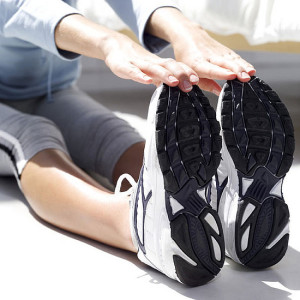It’s a common misconception that static stretching as part of your warm-up will help to prevent injury. Static stretching refers to taking the muscle into a lengthened position and holding it for around 30 seconds to increase flexibility and range of motion. Static stretching increases muscular compliance. Compliance is essentially the pliability of a muscle. Muscular compliance increases with an increase in temperature, just like how it’s easier to stretch a warm versus a cold rubber band. An increase in the temperature of a muscle can be created by stretching. More compliant tissue s absorb less force which is not necessarily a good thing. When a muscle is warmed and compliant, it can stretch farther before it is injured, however, it takes considerably less force to create an injury.
s absorb less force which is not necessarily a good thing. When a muscle is warmed and compliant, it can stretch farther before it is injured, however, it takes considerably less force to create an injury.
It is important, when discussing flexibility, to distinguish between sarcomere length and overall muscular length. A sarcomere is the fundamental unit of a muscle; many sarcomeres make up one muscle. Sarcomeres are composed of thick and thin filaments that overlap and grab on to each other to shorten the muscle and thus create a contraction. When sarcomeres are stretched with static stretching, the filaments no longer overlap. This means that they can no longer grab on to one another to shorten the muscle and create a contraction, and instead, the energy is dissipated outward, causing damage to the muscle. In other words, by static stretching, you are giving your muscles a signal to shut down and relax.

Research indicates that static stretching increases range of motion not only by increasing compliance, but by increasing one’s tolerance to stretch through anesthesia. Static stretching alters our ability to sense pain at a certain range. This pain is necessary as it has a protective function; it stops us from stretching our muscles to the point of injury.
This is not to say that all stretching is bad. A proper warm-up and sport specific dynamic stretching have been proven to be beneficial to performance. Dynamic stretching refers to movements that mimic sport specific actions. (Examples for runners include A’s, B’s, and C’s and leg swings.) Static stretching does have its place. I find chronic static stretching (making it part of your daily routine and not necessarily part of your warm-up) is useful for runners who have difficulty firing certain muscle groups, those with chronic tendonopathies, chronically tight muscles, as well as those with altered biomechanics and sport specific needs.
To summarize, static stretching does not prevent injury, nor does it prevent or reduce delayed onset muscle soreness from a work out. A proper warm up consisting of dynamic stretching and sport specific activities however, has been shown to increase performance.
Dr. Julia Callaghan, B.Sc. (Hons), DC, CSCS, ART®,Contemporary Medical Acupuncture, is a regular contributor to the RunWaterloo blog.
References:
Schrier, I. Gossal, K. Myths and Truths About Stretching. Phys and Sports Med 2000; 28(8)
Ostering, LR. et al. Differential response to PNF stretching techniques. Med Sci Sports Exercise 1990; 22
Pajaczkowski, J. Stretching the Truth. Lecture 2011

